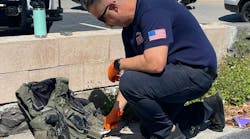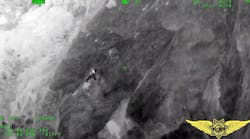Responding to large-scale incidents at schools is something law enforcement has grappled with for decades. Columbine in 1999, to Parkland in 2018, to Uvalde last year, and the Covenant School shooting this past March; these tragic occurrences are only becoming more common. Agencies throughout the country have been working to develop new tactics and policies to respond to such events. At the same time, public safety-focused technology companies have been hard at work on new software to help prevent them, and mitigate common issues in the aftermath.
This article appeared in the November/December issue of OFFICER Magazine. Click Here to subscribe to OFFICER Magazine.
RapidSOS recently held a roundtable with representatives from ZeroEyes, Raptor Technologies and Pikmykid, where the challenges faced when it comes to finding ways to keep students, teachers and first responders safe, while also keeping parents informed were discussed.
Identifying challenges
Motorola Solutions released the findings of its 2023 K-12 School Safety Report in August prior to the current school year. The survey captured the sentiments from 1,000 K-12 parents and 1,000 K-12 educators across the U.S. The data shows that 67% of parents and teachers are much more concerned about school safety now than they were five years ago, even as 73% of parents and 80% of teachers expressed confidence in their school’s emergency response plans.
Parents and teachers both rank school safety as a critical factor (66% for parents, 72% for teachers). Student mental health also continues to be a top concern: Sixty-four percent of parents and 68% of teachers are very or extremely concerned about students’ mental health. Additionally, parents and teachers are worried about the mental health of community members who may perpetrate acts of violence on a school campus and teachers’ mental health.
While 71% percent of teachers say that their school has adopted new safety technology in the last two years, 54% of parents say they haven’t seen new technologies implemented. Close to half of parents say panic button applications allowing teachers and school staff to quickly notify 911 would increase their confidence in their school’s safety.
Karin Marquez, Chief Public Safety Brand Officer with RapidSOS, says the attention to school safety is as high as it’s ever been, with state legislators across the country introducing new funding and policies to advance security and safety. “From enhancing situational awareness to facilitating rapid response, school safety technology covers an array of crucial aspects, starting with situational awareness. Modern safety solutions offer real time situational awareness, allowing schools to monitor their premises and respond promptly to any potential threats,” she says. “This awareness is powered by a combination of sensors, cameras and AI driven analytics that detect unusual activities or anomalies. Panic buttons and mobile safety applications empower students and staff alike to initiate instant alerts, notifying school administrators and first responders.”
According to Marquez, artificial intelligence and gun or weapon detection can play a pivotal role in early threat detection. “AI algorithms can identify sounds like gunshots or even detect the presence of firearms through security camera feeds, enabling an immediate alert and response. Sophisticated indoor mapping solutions provide emergency responders with a clear understanding of the school’s layout. This aids in efficient navigation during crisis and helps responders make informed decisions. Various sensors from motion detectors to environmental monitors contribute to a comprehensive safety network. These sensors provide data that helps schools respond to emergencies.”
Following an emergency, she says reuniting students with their parents or guardians is a critical process. Reunification applications can help streamline this process, ensuring a secure and efficient way to account for every student and maintain order during a potentially chaotic time. “It’s really important that we break down, not only the silos that are present at the school itself, but ensure the communication and data can flow into the 911 center because that is going to be the first point of contact to get those resources right,” she says. “Then that data has to flow also to our first responders in the field, ensuring that they have the best picture so we can focus on what needs to get done and get through the emotional response we’re going to have when we respond to these types of incidents.”
Marquez stressed the importance of training and practice sessions. “Bringing it all together to make sure from activation to reunification that we know exactly what to do, that we’re trained and everybody is speaking the same language,” she says. “What we’ve also seen since Columbine is that interoperability has been such a challenge. Not only do our solutions have to communicate, but the way that we’re training and testing and drilling. We have to do that also together, so that when that emergency does occur, we have the best textbook with as improved outcomes as possible.”
Detecting threats early
Dustin Brooks, the Chief Customer Officer and co-founder of ZeroEyes, which focuses on AI gun detection, says that analytics can help bring together the existing infrastructure camera systems that already exist in order to alert users to certain events.
“We need to be able to create a force-multiplier; take one person and be able to give them resources everywhere to be able to connect with their school district,” he says. “For preemptive security measures, the Parkland shooting is the reason why our company was founded. There was an individual that was in a stairwell prepping before the shooting and was in plain sight of a camera system. Our question was ‘If there had been a proactive position at this building, could we have identified something and had been able to provide more resources that could potentially have benefited responders there in a situation like that?’ ”
He added that companies developing new technologies for school safety are constantly trying to figure out the best practices and that there’s no turnkey solution for any organization, whether it be a K-12 environment or a corporate center. “It’s all different across the landscape,” he says. “When you look at technology to support first responders, you really have to build a relationship with those individuals, see what they’re already doing, how they’re already communicating and where can you best position yourself to effectively enable those positions.”
Whenever artificial intelligence and object identification software is involved, there will be privacy concerns. Brooks believes that education is key to getting public buyin. “Our analytic is based specifically on object detection,” he says. “We have an operation center that is working for our customers, filtering through alerts that come in, and they don’t get an alert unless there is one that is triggered by an object. We’ve had gun detections of the Matrix movie playing in the background on a movie screen. That is obviously not a threat, but we’ve got a human in a loop who determines that. We’re specifically looking for guns. We’re not identifying faces. We’re not identifying clothing. We’re not identifying body positioning. We’re looking for one particular thing.”
He adds that technology can help sift through the vast collection of data that would be difficult for humans to do on their own. “There’s a strength to understanding where a threat is, but there is also a strength in understanding where the threat is not as well.”
Developing best practices
David Rogers, the Chief Marketing Officer for Raptor Technologies, says technology is just one piece of the puzzle, and that school safety and security should be looked at as layers. “There are physical layers, there’s technology, but then there’s also the people who make it work. A lot of times, quite frankly, that’s the part that doesn’t always function correctly because they haven’t practiced, or haven’t followed procedures,” he says, adding that another layer is the speed at which information is delivered. “When you’re dealing with an active shooter event, getting as much information as possible as fast as possible to first responders is really going to help save lives. Every second counts.”
He also stresses that there are a lot of different applications involved and that another layer in school safety is having those applications communicate with each other. “Gone are the days of silos for technology and school districts, where companies could just kind of put a barrier around the access to the information,” he says. “We are all actively trying to knock down those data barriers that exist between safety applications and technologies. I think those three things are really key when you look at how technology plays a part in school safety.”
According to Rogers, it’s the rich data collected that gives law enforcement the context of the emergency and that simply activating a button doesn’t necessarily provide the context. They need to know that kind of information,” he says. “I think knocking down those silos really helps to expedite the response to these types of emergencies.”
He also says it’s important companies need to make sure the technologies that are deployed utilize a lot of the hardware and resources that schools already use every day. “Trying to introduce something new to the equation that they’re not used to utilizing usually throws it off,” he says. “I think technology companies need to make it affordable. They need to leverage the technology that’s already in place; particularly the hardware at these school districts.”
Fixing reunification
Pat Bhava, founder and CEO of Pikmykid has a personal connection to the challenges of reunification. His daughter went missing during school dismissal, leaving him to create Pikmykid to provide technology that enhances school safety from the time a student arrives until they return safely home. Before Pikmykid, Bhava says there were not a lot of applications available for coordinating reunification. “We have a plethora of tools to manage and handle emergencies, but what happens with the recovery? Usually, after any incident, this is played out on live TV for hours on end when reunification takes place painfully slow and much to the detriment of the mental and physical well-being of our children and the entire community.”
According to Bhava, technology should be used to handle the task of connecting parents and kids together in order to take that load off teachers and staff who can then focus on more important things associated with recovery after an emergency. He also believes that a big part of reunification is making sure that all of the parties involved, including law enforcement, are familiar and trained in using the software and applications being used. “If you don’t practice on the same platform every single day, when emergency strikes the stakeholders are pretty much lost like you,” he says. “You can’t expect them to use a new platform or something they’re unfamiliar with when things go wrong, so they’ve got to be very conversant with the platforms. The more we practice on a daily basis, the more we are prepared in an emergency.”
Rogers agrees on the challenges of reunification, adding that for a long time, the complexity of reunification has been underestimated. “It’s like throwing a mini concert,” he says. “If you’ve got 500 kids at a school, you’re going to have 1,500 people show up to pick them up. You have to be able to communicate with those guardians. You’ve got to make sure you have a way you’re handing off to the right kid and you’ve got do it quickly and efficiently. It’s one of those things that people don’t always think about in the event of emergency until you get to a point like you saw at Parkland, where it was just so painful to watch and everybody realized, ‘Oh, we’ve got to do something about this.’ ”



